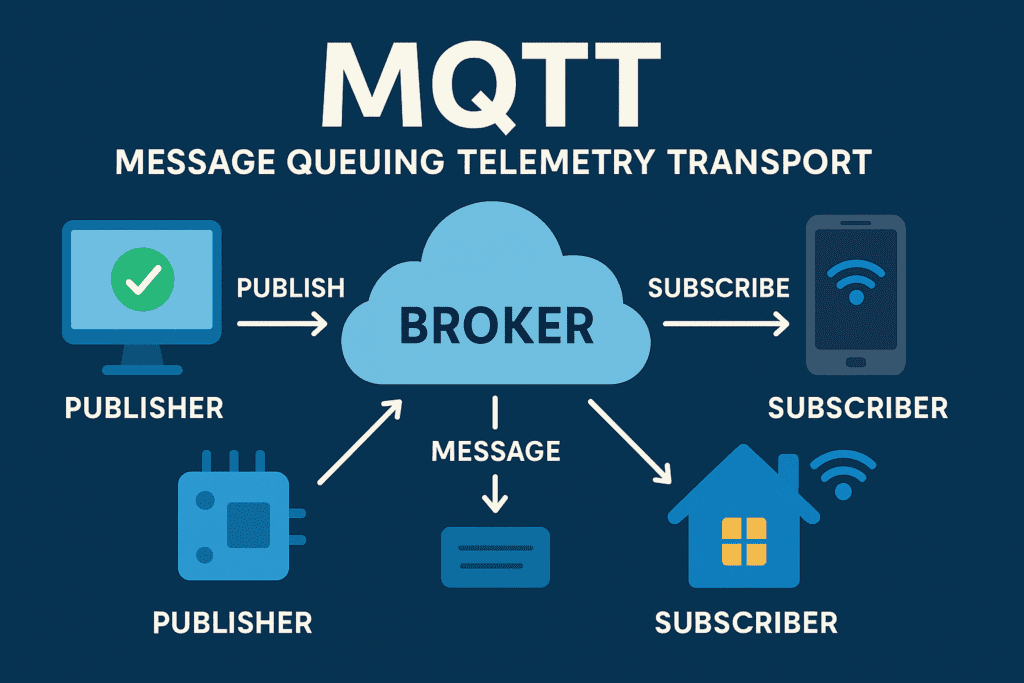
Introduction to Implement MQTT Data communication
In this guide, we explore Implement MQTT Data communication using AWS IoT Broker and PahoMqtt in Ruby on Rails. MQTT (Message Queuing Telemetry Transport) is a lightweight messaging protocol designed for real-time data exchange, ideal for IoT applications. We will walk through setting up MQTT with AWS IoT Broker and integrating it seamlessly into a Ruby on Rails application to enable efficient, scalable communication.
Understanding MQTT Data Communication
MQTT (Message Queuing Telemetry Transport) is a lightweight messaging protocol that is designed for machine-to-machine communication. It is a popular choice for IoT applications because it is efficient and can be used over low-bandwidth networks.
Why Choose MQTT for Data Communication
Data communication with MQTT offers a number of advantages over other messaging protocols, including:
- Lightweight: MQTT messages are small and efficient, which makes them ideal for low-power devices.
- Efficient: MQTT uses a variety of techniques to reduce bandwidth usage, such as batching messages and using efficient transport protocols.
- Reliable: MQTT can deliver messages reliably, even in the presence of network errors.
- Easy to implement: MQTT is easy to implement on a variety of devices, including microcontrollers and single-board computers.
- Easy to use: MQTT is easy to use, with a simple publish/subscribe model.
Key Benefits MQTT
The benefits of using MQTT include:
- Reduced bandwidth usage – MQTT can significantly reduce bandwidth usage, which is important for IoT applications that need to transmit data over low-power networks.
- Improved battery life – MQTT can improve battery life on battery-powered devices by reducing the amount of data that needs to be transmitted.
- Increased scalability – MQTT is scalable to support large numbers of devices and messages.
- Improved reliability – MQTT can deliver messages reliably, even in the presence of network errors.
- Reduced latency – MQTT can contribute to reducing latency in communication systems due to its lightweight and efficient nature
- Improved security – MQTT can be used to implement secure communication between devices.
Real‑World MQTT Data Communication Use Cases
- Industrial IoT: Industries use MQTT to collect data from sensors and machines in plants, monitoring production processes, identifying potential problems, and optimizing performance.
- Smart Homes and Buildings: MQTT connects smart devices like thermostats, lights, and appliances in homes and buildings, enabling automation, energy management, and remote control.
- Connected Vehicles: Vehicles use MQTT to collect data from sensors, monitor performance, diagnose problems, and provide real-time traffic updates.
- Wearables and Healthcare: Wearable devices like fitness trackers and smartwatches rely on MQTT to track activity levels, monitor vital signs, and deliver health insights.
- Smart Grids and Energy Management: Power grids leverage MQTT to gather data from smart meters and sensors, monitoring energy consumption, detecting outages, and optimizing distribution.
- Retail and Customer Experience: Retailers utilize MQTT to collect data from sensors and devices, tracking customer behavior, optimizing store layouts, and offering personalized shopping experiences.
- Agriculture and Precision Farming: Farmers implement MQTT to gather data from field sensors, monitoring soil moisture, temperature, and crop health, which supports precision farming techniques.
These are just a few examples of the many real-time use cases of MQTT. As the IoT continues to grow, MQTT is becoming an increasingly important protocol for connecting devices and collecting data.
MQTT Data Communication Basics:
How MQTT Data Communication Works
MQTT is a publish/subscribe protocol. This means that devices can publish messages to topics, and other devices can subscribe to those topics to receive the messages. MQTT brokers are responsible for routing messages between devices.
The basic workflow of MQTT is as follows:
-
A device connects to an MQTT broker: The device establishes a connection with an MQTT broker, which is a server that manages the communication between devices and subscribers.
-
The device publishes messages to topics: The device publishes messages to topics, which are hierarchical strings that are used to organize messages. For example, a sensor might publish messages to the topic
sensors/temperature. -
The broker stores and forwards messages: The broker receives the published messages and stores them in a queue. It then forwards the messages to all clients that are subscribed to the relevant topics.
-
Clients subscribe to topics: Clients, which can be applications or data processing systems, subscribe to topics to receive messages. They can subscribe to multiple topics or just a single topic.
-
The broker forwards messages to subscribed clients: When the broker receives a message for a topic that a client is subscribed to, it forwards the message to the client. The client then processes the message.
MQTT Topics and Messages:
MQTT Topics:
In MQTT, topics are hierarchical strings that are used to organize messages. Messages are published to topics, and clients subscribe to topics to receive messages. Topics are separated by slashes (/), and each level of the topic represents a more specific categorization of the message. For example, the topic sensors/temperature represents messages about the temperature from sensors.
MQTT Messages:
MQTT messages are the data that is published to topics. They consist of a payload, which is the actual data being sent, and a header, which contains additional information about the message, such as the topic, the message ID, and the quality of service (QoS) level.
Examples of MQTT Topics & Messages
-
Smart home automation:
- Topic:
sensors/temperature - Message:
{"temperature": 25.4}
This message indicates that the temperature is 25.4 degrees Celsius.
- Topic:
-
Industrial automation:
- Topic:
machines/factory1/machine1/status - Message:
{"status": "running"}
This message indicates that machine 1 in factory 1 is running.
- Topic:
-
Connected vehicles:
- Topic:
vehicles/car1/location - Message:
{"latitude": 37.7833, "longitude": -122.4167}
This message indicates that car 1 is located at 37.7833 degrees latitude and -122.4167 degrees longitude.
- Topic:
Top MQTT Brokers
MQTT brokers are software applications that manage the communication between MQTT clients. They handle the process of receiving messages from clients, storing messages in a queue, and delivering messages to subscribed clients. There are many different MQTT brokers available, each with its own features and capabilities.
Here are some of the most popular MQTT brokers:
-
Mosquitto: Mosquitto is a popular open-source MQTT broker that is available for a wide range of platforms, including Linux, macOS, Windows, and Docker. It is a lightweight and easy-to-use broker that is well-suited for a variety of applications.
-
EMQX: EMQX is a high-performance and scalable MQTT broker that is designed for enterprise applications. It supports a wide range of features, including authentication, authorization, and clustering.
-
VerneMQ: VerneMQ is another high-performance and scalable MQTT broker that is known for its reliability and ease of use. It supports a wide range of features, including authentication, authorization, and clustering.
-
AWS IoT Core: AWS IoT Core is a managed MQTT broker that is offered by Amazon Web Services (AWS). It is a scalable and secure broker that is well-suited for cloud-based IoT applications.
-
Azure IoT Hub: Azure IoT Hub is a managed MQTT broker that is offered by Microsoft Azure. It is a scalable and secure broker that is well-suited for cloud-based IoT applications.
Popular MQTT Clients
MQTT clients are software applications that enable devices to communicate with MQTT brokers. They handle the process of connecting to a broker, subscribing to topics, and publishing messages. There are many different MQTT clients available, each with its own features and capabilities.
Here are some of the most popular MQTT clients:
-
Mosquitto: Mosquitto is a popular open-source MQTT client that is available for a wide range of platforms, including Linux, macOS, Windows, and Android. It is a lightweight and easy-to-use client that is well-suited for a variety of applications.
-
Paho-MQTT: Paho-MQTT is a cross-platform MQTT client library that is developed by Eclipse Foundation. It is available for a variety of programming languages, including C, C++, Java, Python, Ruby, and JavaScript. Paho-MQTT is a powerful and versatile client library that is well-suited for enterprise applications.
-
EMQX C/C++ Client: EMQX C/C++ Client is an open-source MQTT client library for C and C++ applications. It is a high-performance and scalable client library that is designed for demanding IoT applications.
-
MQTT-C Client Library: MQTT-C Client Library is an open-source MQTT client library for C applications. It is a lightweight and easy-to-use client library that is well-suited for embedded systems.
-
MQTTnet: MQTTnet is an open-source .NET MQTT client library. It is a powerful and versatile client library that is well-suited for a variety of .NET applications.
MQTT QoS Levels Explained
MQTT supports three Quality of Service (QoS) levels to balance latency and reliability based on your application’s needs:
QoS 0 – At Most Once:
This is the fastest and least reliable level. Messages are sent once with no acknowledgment, making it ideal for low-latency applications like video or audio streaming, where occasional message loss is acceptable.
QoS 1 – At Least Once:
With this level, the broker ensures the message is received at least once. It’s well-suited for reliable communication, such as sending sensor data or control commands. However, it may result in duplicate messages.
QoS 2 – Exactly Once:
This is the most reliable level, guaranteeing that each message is delivered only once. It’s the best choice for critical systems, including financial transactions or medical data, where data accuracy is crucial — despite the higher latency.
MQTT vs HTTP for Data Communication
The key differences between MQTT and HTTP:
| Feature | MQTT | HTTP |
|---|---|---|
| Protocol type | Publish-subscribe | Request-response |
| Statefulness | Stateful | Stateless |
| Bandwidth usage | Lightweight | Can be bandwidth-intensive |
| Latency | Low latency | High latency |
| Reliability | High reliability | Less reliable |
| Use cases | Real-time applications, IoT | Web applications, data transfer |
Why MQTT Data Communication Beats HTTP
MQTT is a better choice for smart home applications than HTTP because it is lightweight, low-latency, and reliable. These characteristics are essential for a smart home system, which needs to be able to collect data from sensors and devices in real time, even over unreliable networks.
Here are some specific reasons why MQTT is better for smart home applications:
-
Real-time data collection: MQTT’s publish-subscribe model allows devices to publish messages to topics in real time. This means that clients can receive messages as soon as they are published, without having to poll for updates. This is essential for real-time applications, such as smart lighting and thermostats.
-
Low-bandwidth networks: MQTT is a lightweight protocol that is designed for use with resource-constrained devices and low-bandwidth networks. This makes it ideal for smart home applications, which often involve devices with limited battery life and limited network connectivity.
-
Reliability: MQTT is a reliable protocol that includes features such as message persistence and duplicate detection. This ensures that messages are delivered reliably even in the event of network disruptions. This is important for smart home applications, where it is critical to ensure that devices can communicate with each other even if the network is unstable.
In addition to these technical advantages, MQTT also has several practical advantages for smart home applications. For example, it is a widely supported protocol, with a large number of open-source libraries and tools available. This makes it easy to develop and deploy smart home applications using MQTT Data Communication.
I would like to thank Google Bard for its helpfulness and insightful suggestions in writing this article.
Conclusion
Now that you’ve seen how MQTT Data communication, works to build real-time applications for smart homes, vehicles, and industrial systems.
References
Here are some of the best reference links for learning more about MQTT Data Communication:
- MQTT Essentials: https://www.hivemq.com/blog/mqtt-essentials-part-1-introducing-mqtt/
- MQTT online courses: https://www.udemy.com/topic/mqtt/
- Additionally, you can also read – https://engineering.rently.com/aws-s3-how-to-implement-security-best-practices-in-it/
Part 2 – Practical Examples in Rails: Exploring MQTT Implementation in Real-Time Messaging
Senior Software Engineer

